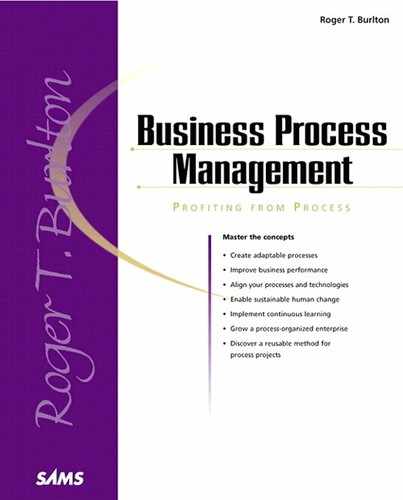Identifying Performance Improvement Targets
This step defines the measurement indicators to be used to evaluate process performance today and in the future. It also targets the degrees of performance improvement based on potential and risk.
Figure 12.3 earlier in this chapter shows an example of the knowledge produced as a result of this step.
Techniques
The technique of identifying performance improvement targets resembles techniques from the business context phase but focuses on the specific expectations and needs for the project which will deliver improvements to the “Process-in-Focus.” Techniques include
Key performance indicator analysis
Balanced scorecard analysis
Performance benchmarking
Negotiation
Consensus workshops
Lessons Learned
Process performance objectives are absolutely essential to drive and guide a project forward. Targeting an 80% reduction in elapsed process time is a completely different project than trying to improve every aspect of the process by 10% (especially political and change management issues). Deciding how far a renewal project will go is the most important executive commitment made yet. It will be your source of empowerment for what you have to do, so set challenging goals but make sure that the numbers are somewhat attainable.
Start with a stakeholder relationship balanced scorecard and key performance indicators (for example, customer satisfaction) and then derive contributing process key performance indicators (KPIs—for example, on-time delivery).
For each stakeholder, identify or confirm KPIs for assessing attainment of the vision. Look for measures of effectiveness, efficiency, and adaptability. Rationalize the set of KPIs into a manageable number (maximum 5) for the overall change and compare any existing performance data against these KPIs. Determine the degree of performance improvement (stretch goals) in each of the KPIs that’s required to meet the stakeholders’ needs.
This activity looks remarkably simple on the surface, but finding KPIs that truly reflect the process under review and not a range of other processes (such as overall customer satisfaction) is very hard to do. Determining how to measure KPIs without becoming obtrusive is even harder. You can affect the performance of workers, who believe that they are being measured personally. Workers might perform better if they believe that they are being watched. If they believe that they might be held accountable for a work standard to be set by measurement, they might slow down. In both cases, they change their normal behavior, and the project moves forward based on erroneous performance results. Without reasonably accurate measures against the KPIs, decisions can be made and processes designed that won’t improve the real work flow.
